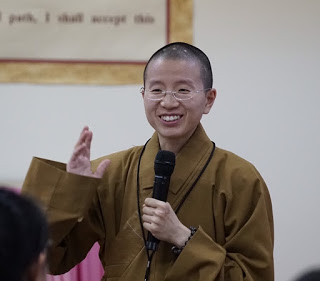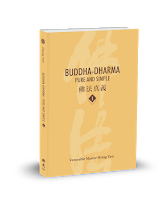
Speaker: Venerable Zhixing
Fo Guang Shan Hsi Lai Temple, Los Angeles
I. Introduction: Suffering in Buddhism
Auspicious greeting to all friends from around the world! This is Venerable Zhixing from Fo Guang Shan Hsi Lai Temple in Los Angeles, United States. Thank you for joining our online English Dharma service. It is nice to share the Dharma with you all again.
When we learned more about Buddhism, we might notice that Buddhism talked about suffering a lot. It talked about all kinds of suffering that we have, whether it’s suffering from getting old, getting sick, dying and so on. Some people think that it is very pessimistic and negative. However, this is actually not the case. The Buddha once said, “All I teach is suffering and the end of suffering.” What the Buddha emphasizes more is the ending of suffering. He told people about suffering first because it helps us recognize the various kinds of suffering in our life. Through seeing and learning about them, we would be inspired to following the Buddha’s teaching in ending these sufferings. If we take some time and self-reflect, all of us has the innate nature to get rid of suffering and find happiness, though whether satisfying our desires is real happiness or not is another question that we need to analyze.
2,500 years ago, Prince Siddhartha did the same. He saw the suffering of old age, sickness and death. This inspired him to leave the palace and went on a quest to find ways out of these suffering. Ultimately, he attained enlightenment under the bodhi tree, realized the truth of the universe, and became the Buddha—the awaken one.
From the story of the Buddha, we can also get a gleams of what Buddhism is about. It’s basically about suffering and ending of suffering. This is also clearly demonstrated by the fact that the first teaching that Buddha taught to his disciples was the Four Noble Truths:
(1) suffering
(2) causes of suffering
(3) cessation of suffering
(4) path to cessation of suffering.
Like a doctor, the Buddha first told us about the sickness we are suffering from. He then gave a diagnosis of the sickness we have and told us the cause of them. Afterward, he prescript the medicine to us so that we can be freed from sickness.
II. First Noble Truth: Suffering
The first noble truth, dukkha, is generally translated as suffering, but suffering is just one of the aspects of this word. It doesn’t just mean physical pain, but mental suffering as well.
We all face various suffering in our life or we see them around us. We all need to face the fact that we are growing older each day. When we are old, we are facing the fact that our life is one day shorter. During the COVID-19 pandemic, we all see that over 12 millions people suffered from this disease, and over five hundred sixty thousand people died from it. We see news of people died from murder, from the pandemic and we see the death of our family and friends. We may be disappointed and angry from not getting what we want or we may be angry and frustrated over having to work with someone whom we dislike or someone who push our buttons. We might be stressed over the inevitable changes in our life.
Let me ask you: Do you have suffering in your life? Do you know that you have suffering in your life? In order to seek the ultimate happiness and eliminate all defilement in life, it is very important for us to know the suffering in our life, so that we will be motivated to change. If we do not know that we have sufferings in our life, we would not even start on the spiritual journey to cultivate in the first place. We have a tendency to divert our attentions from our problem, or not wanting to face them. We believe that life can go on as usual. Bad thing will just go way. Or we might just dwell in things that give us short-term happiness, whether it’s attending a barbecue party, hanging out with friends, watching a movie or traveling. Venerable Master Hsing Yun once told us that we need to know the defilements, afflictions and suffering that we have. We need to be aware of them before we can start to change.
III. The Second Noble Truth: Cause of Suffering
The second noble truth is cause of suffering. A lot of time, when we try to identify the cause of our stress or defilement, we tend to think that it is because of other people or the external conditions. It is someone who give me trouble. It is the environment. Our finger always seems to point at others, but not ourselves.
However, the Buddha told us otherwise. He told us that the root of suffering lies in our “thirst” or we called it our craving. In another word, the strong desire or craving in our mind is the principle condition for suffering. This craving is also called “unquenchable thirst” because these desires can never be satisfied. We have many cravings in our life. We might like to see beautiful things, or listen to beautiful sounds, smell good fragrance, taste delicious food or drinks, or enjoy soft, smooth touch. People might get into conflict, fight or commit unwholesome deeds to try to acquire these sensual objects. We would be happy if we get them successfully. However, anger and aversion would arise when we fail. Our craving is based upon our ignorance, not seeing the world as it truly is, but what we think it is. In another word, the cause of our suffering is from our greed, anger and ignorance.
IV. The Third Noble Truth: Cessation of Suffering
The third noble truth is known as the cessation of suffering. It is a state of mind with no more greed, anger, and ignorance. It is the end of suffering, discontent, distress and sorrow. It is a state of total freedom from self-attachment and all causes of suffering. Thus, it is also called unbinding. Why are we free and unbind? It is because we realize the profound truth. We see the world and all conditions as they truly are, therefore, we are not attached to them. This brings an end to our craving. Cessation of suffering is also sometimes called “extinguishing the fire”– the fire of struggle, resistance, anger, aversion, and the attempts to fulfill our endless desires.
V. The Fourth Noble Truth: The Path to the Cessation of Suffering
Now that we know it is possible for us to be freed from suffering, we would be inspired to follow the path that leads us to that goal. This is the fourth noble truth – the path to cessation of suffering. This path is also a path taken by all Buddha in the past. It is called the Noble Eightfold path. They are:
(1) Right view
(2) Right thought
(3) Right speech
(4) Right action
(5) Right livelihood
(6) Right effort
(7) Right mindfulness
(8) Right concentration
They are not eight separate training, but rather they are like a tapestry that is interwoven in our life. The Buddha told us that “our mind is like the painter who can paint our world and create everything.” We have the power to create our own world, whether it is chaotic or peaceful. What kind of world do you want to live in? Sometime, we choose to do things that might give us temporary happiness but leave us in suffering afterward, such as drinking, smoking or gambling. Other people might play online games to divert their attention from the problems in their life. We know that it’s not good for us but we can’t help ourselves. Therefore, the question here is not really about whether we are able to free ourselves from pain and suffering, but rather whether if we really want to free ourselves. The Buddha had told us the path to cessation of suffering. We just need to be determined and practice it.
VI. Applying the Four Noble Truths in Daily Life
How can we apply the four noble truths in our life? We can actually apply this teaching whenever we encounter problems in our life, whether it is an external matter or it’s afflictions in our mind.
Let us use the problem of dealing with anger as an example. When things didn’t go according to what we want or didn’t go according to plan or when unexpected situation arise, we get upset or angry easily. There are some people who get angry easier as compared to others. When we get angry, we act irrationally without thinking of the consequences. We may say things or do things that we regret later. In serious case, it may lead to harm to others, conflict with others or it might even lead to losing our job. However, we just can’t seem to control our emotion at the moment even though we know that it is wrong. This is the suffering of having problem in managing our anger. The causes of all these suffering obviously is due to our anger. Our ultimate goal is to be able to maintain equanimity at all time. We can only see all situation with clarity with a calm and peaceful mind.
Now the question is how do we achieve this goal and be able to manage our emotion? Venerable Master Hsing Yun once told us that to better manage our emotion, especially anger, it takes several steps:
1. Not to react to our anger
Once we know that we have problem with managing our anger, we need to first remind ourselves to not react to the anger the moment anger arises. We might still look very angry, but we tell ourselves not to talk or not to act upon it. This is the first step. It does take time to just to achieve this first step because we often just react to our emotion before thinking.

2. Not to react and not to show anger on our face
Once we can control our action and speech, the next step is to tell ourselves not to show anger on our face even if we are still very angry. Thus, at this second step, we might still be angry in our mind, but we don’t show it on our face and we don’t react to it.

3. Not to be angry in the first place
Once we succeed, the last step is to not be angry at all. We are able to handle the situation with calmness and clarity. The key point to working on each of these steps is actually maintaining right mindfulness. What this mean is that we are mindful of our thoughts and feeling at all time. Only if we are mindful of the feeling we have, would we be able to remind ourselves not to react.

We can train this sense of mindfulness through practicing meditation daily. We might find it hard to fit the practice in our busy schedule. One can start with meditating, focusing on your breath, 10 minutes before you go to bed or when you wake up in the morning.

4. Figure out the causes of our anger
Another way to help us to cool down our anger is to figure out the causes of our anger. Anger doesn’t just arise out of the blue. There is always a reason why we get angry. It might be because we are being wronged, or because we didn’t get what we want or because of miscommunication.
Recently, someone shared a drawing with me. On the drawing was a man lying at the edge of the cliff trying to pull his girlfriend who is hanging by the cliff up. However, the man was pinned down under the huge rock that lied across his back. On the wall of the cliff, a poisonous snake was hissing at the girlfriend. The man was angry with his girlfriend for not trying to reach up and climb the cliff. The woman was angry with her boyfriend for not trying to pull harder. Both people only saw what was in front of them and didn’t see what the other was currently facing. Thus, misunderstanding arose.

We might think that they are silly. However, how often does this happen in our relationship with others. Because we don’t understand why others behave the way they do or where they are coming from or why they think in such way, we easily believe what we see or what we hear and become angry with them. If these are the causes of our anger, then we should learn to change our perspective, learn to think from other’s perspective and try to understand where they are coming from. Sometime, if we understand and if we change place ourselves in their shoes, we would be able to let go of our anger.
So next time when you become angry, sad, frustrated, try to identify the causes of that make you feel as such. Once you identify the causes, try to come up with a solution to resolve the issue. A lot of time, you might find that it’s really about changing your perspective.
Identify the problem
Figure out the causes of the problem
Find a solution to resolve the issue
Actualize the solution
Last, but not least, thank you for joining us in this cultivation session. May Buddhas and Bodhisattvas bless everyone with happiness and peace. May everyone be safe and well. Omitofo.
Read more about Four Noble Truths!
Buddha-Dharma: Pure and Simple 1

In today’s Buddhist sphere, numerous claims have been made on what the Buddha has taught. However, were they truly spoken by the Buddha? The Buddha-Dharma: Pure and Simple series is an exploration of over 300 topics, where Venerable Master Hsing Yun clarifies the Buddha’s teachings in a way that is accessible and relevant to modern readers. Erroneous Buddhist views should be corrected, the true meaning of the Dharma must be preserved in order to hold true to the original intents of the Buddha.
Published by: Fo Guang Shan Institute of Humanistic Buddhism
Read it here

